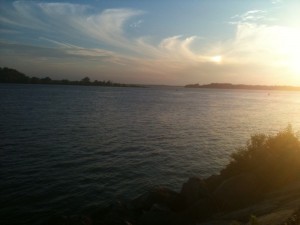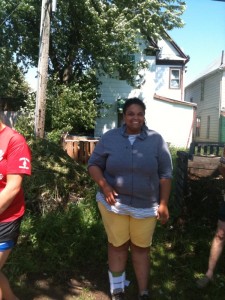(This is the third in a series of posts by Executive Director, Kirsten Moller as she pedals her way to the US Social Forum. Read on as she shares her journey from Upstate NY to Detroit and the lessons learned along the way.)
I promised I’d tell you about the Urban Fish in Buffalo, but the Bike-It days got into a groove of 70 plus mile days, rolling into the campgrounds as the sun was setting and the mosquitoes emerging, without a computer in sight. The days settled into a regular routine of waking with the sun, eating, packing lunches, pedaling off in our groups based on ability — the fast ones, the fast ones with breaks, the slow and steady ones and the ones hoping for a ride in the sag wagon. Pedaling along the shores of Lake Erie in Canada, with the elegant windmills significantly outnumbering the oil/gas pumps and the wheat fields gradually becoming golden was enormously satisfying.
Days ago we arrived in Buffalo after a long day along the tow path of the Erie Canal entering the city along the water front where rollerbladers, baby strollers, dog walkers and bicyclists shared the path and the gorgeous sunset. Unfortunately, as the path entered Buffalo proper, we passed a huge coal fired plant and a neighborhood of dying steel plants. Coming in the back door like that we saw so many boarded up shops and decaying industrial parks. It was shocking after the beauty of the day.
Buffalo actually has the lowest unemployment in the state according to Wikipedia, but only because thousands of people have already left the the city. As one young man told me, the people who are still here, are the ones who can’t afford to leave.
We were hosted by the Massachusetts Avenue Project (MAP), sleeping in their library/community center which was given to them by the city after the county gave up on maintaining branch libraries. We slept among the stacks of books and spent a day volunteering on the project’s local city farm. The MAP is a youth and family empowerment project that is dedicated to improving access to fresh, healthy and culturally appropriated foods in the local “food desert”. “A food desert” explained our host Zoe, “is an area where there is no grocery store within walking or easy bus distance.”
Because of the rapid depopulation of the Buffalo area, there are more than 2,500 vacant lots in this food desert. MAP was founded as a block club in response to gang violence. They established a commercial kitchen and started farming on two vacant lots across from the center.
Now the project employs 35 youth who grow 40 – 45 different kinds of vegetables, fruits, herbs and flowers. They grow chickens and, yes FISH in hydroponic systems under hoop houses that swelter in the summer sun.
Erin, Zoe and Jesse are the farm staff working with “Growing Green” and they show a real understanding of how to make a youth program that is real, respectful and provides tools for a healthy future. Erin works with a group of teens to do event promotion and production, graphic design for posters, brochures and labels and savvy media work. Zoe has a group of social entrepreneurs who create value-added products such as chili starter and salad dressing. The youth do the business plans, production schedules and sell out all of their products to 25 local businesses. Jesse has a group that looks at farm systems, growing food and learning about policy and advocacy work. The students learn to articulate their challenges and identify the source of those challenges and begin to build policy and advocacy goals.
Though it is not a goal, every one of their participants has graduated from high school in a city with a 44% graduation rated and all have gone on to college.
One of the most fascinating projects was the urban fish pond with thousands of organically-fed Tilapia fish swimming (swarming might be a better word) in a large cement tank inside a plastic covered hoop house. The water and fish waste from the fish pond is pumped to the top of the hoop house and waters flats of tomatoes, water cress and basil planted in fine gravel beds. By the time the water filters though the stones it is clear and clean, ready to be oxygenated by being sprayed back into the fish ponds. The plants clean the water, the fish waste feeds the plants in an almost perfectly balanced circle. Extra leaves from the water cress or spinach feed the vegetarian fish who fetch $5 a piece from local restaurants when they reach one pound.
The MAP project inspired us because it was such a successful hands on project that was set in a context of changing relationships in a neighborhood, a city and ultimately in systems of food sovereignty and local control.





